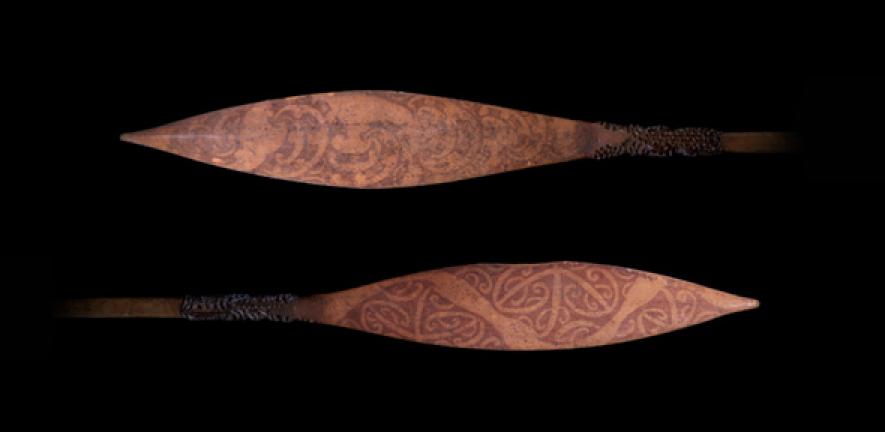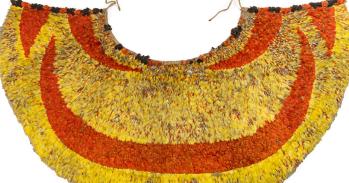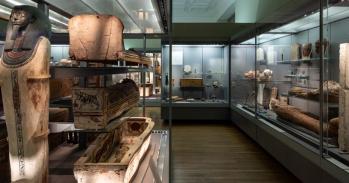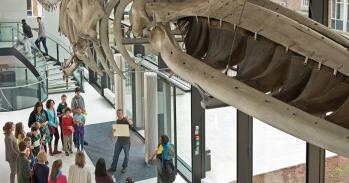
Maori paddles presented to Captain Cook’s crew on their first voyage of discovery capture the spirit of a first encounter between two cultures.
Maori paddles presented to Captain Cook’s crew on their first voyage of discovery capture the spirit of a first encounter between two cultures.
they enter'd into a traffick with our people... giving in exchange their paddles
William Monkhouse, Ship's Surgeon, HMS Endeavour
Living in a multicultural, globalised world, it’s hard to imagine the moment when different cultures first met, or a time when people’s knowledge of each other’s worlds was nonexistent.
Yet, on 12 October 1769, seven Maori canoes paddled out from the east coast of New Zealand south of Poverty Bay to investigate a large ship. The vessel was the HMS Endeavour, captained by Captain James Cook, and this was the first time the Maori people had encountered a European.
They were at first reluctant to approach the ship but then, according to the diary of ship’s surgeon William Monkhouse, “very soon enter’d into a traffick with our people for [Tahitian] cloth… giving in exchange their paddles (having little else to dispose of) and hardly left themselves sufficient number to paddle a shore.”
A set of these finely carved and decorated paddles is now housed in the University of Cambridge’s Museum of Archaeology and Anthropology, where an innovative research project ‘Artefacts of Encounter’ has been working with Polynesian communities to understand what the earliest Europeans to visit the Pacific Islands made of the people they met, and what those people made of them.
Rather than turning to the written evidence of Europeans, the researchers have placed at the heart of their investigation the objects the Polynesians gave in exchange for goods. For the Polynesians, the paddles and pots, feathered cloaks and woven helmets, nose whistles and shell horns are often the only surviving evidence of a contact with other cultures that happened centuries ago.
“Artefacts help us to study what parties on either side of the encounters were trying to achieve through these seminal transactions,” explained researcher Dr Julie Adams. “They help us to consider new evidence of the nature of these encounters and of the changes in social practices, ideas and beliefs they engendered, both in the Pacific and in Europe. Artefacts are key to understanding how socio-cultural change unfolds.”
But with more than 650 voyages from Europe and the Americas entering Polynesia between 1765 and 1840, the artefacts the explorers brought back are both plentiful and largely scattered throughout museums of the world. Artefacts were divided up between crew members as ships returned home; today, no single museum houses the bounty of any single expedition.
Focusing initially on 40 ‘priority’ voyages – among them those of Cook (1768-80), Malaspina (1789-94), d’Entrecasteaux (1791-1793) and d’Urville (1822-40) – the team has re-analysed over 1,000 objects from 30 museums and Carl Hogsden has built a digital research environment that brings them back together for the first time.
Named KIWA after the great Polynesian navigator, the digital resource manages a wealth of widely dispersed data through a series of active collaborations with holding institutions, scholars and Polynesian communities, “enabling the discovery of new connections between hard-to-access material,” as Hogsden explained. KIWA is designed to enable the sharing of data and research insights among the geographically dispersed project team (based in the UK, New Zealand and Brazil) as well as between research and curatorial staff worldwide.
For the Maori wooden paddles, for instance, the researchers have traced back almost 250 years from the artefact to the first encounter – through close study of the wooden paddles themselves, which are intricately decorated in red ochre, as well as through sea charts, ship’s log records, diary entries, inventories and, significantly, discussions with a Maori kin-group whose ancestors may have been among those who exchanged paddles for goods with Cook’s crew.
“The paddles would have been part of a set used to paddle a waka taua, a large canoe embodying the spiritual potency (mana) of a kin-group personified by their chief,” explained Adams. “They were probably given as a gift to Tupaia, the Tahitian priest-navigator-interpreter who accompanied Cook and his men to New Zealand, possibly in an effort to bind him and his own mana to the local genealogical networks.”
Tupaia was to die of typhus at Batavia and his possessions were brought back to Britain, where they were sent by Lord Sandwich, then Lord of the Admiralty and Cook’s patron, to Trinity College, Cambridge, in October 1771. After being exhibited for many decades in Trinity College Library, they were deposited in the Museum in 1914.
Adams, who with Dr Amiria Salmond and others has helped amass the object-centric evidence that underpins the digital resource, explained the resource’s significance: “For the very first time, it is now possible for researchers to reassemble all of the artefacts collected on a certain expedition – such as the Bellingshausen voyage from Russia to the Marquesas Islands in 1803. These are now dispersed across various institutions and have never been studied in their entirety.
“Or researchers could ask the database to show all the carved wooden clubs collected from Tonga, or all objects made from barkcloth, dog skin or feathers, or all the objects collected by an individual, such as the missionary George Bennet who toured Polynesia in the 1820s.”
One aim of the project, which is led by Professor Nicholas Thomas and funded by the Economic and Social Research Council, is to expose variations in patterns of exchange among different island groups (including Tonga, the Society Islands and New Zealand) as well as between different voyages over time. Such a comparative approach will enable new conclusions to be drawn not only about the voyages themselves and their immediate aftermath, but about the divergent trajectories of first imperial, then (post-)colonial relationships.
The project has taken a lead from present-day Polynesians, who assert strong ancestral interests in these encounters and their artefacts. A key aspect of the project has been collaboration with a Māori tribal group, Te Aitanga a Hauiti (represented by the arts management group Toi Hauiti) – whose forefathers encountered early European explorers from the arrival of Cook in 1769. For six months, Hogsden worked with Toi a Hauiti to help create a digital research network that allows the Cambridge-based system to share content with a digital archive under development by the Maori community and local web developers, CodeShack.
“This work forms the basis for a reciprocal relationship between networked research hubs where ownership and control of information lies with the source,” explained Hogsden. “Although the networked content is collaboratively produced, the interpretation of digital objects differs. This is important because the Maori community views objects in a highly relational way – everything is connected to everything else – and so whereas our database is object-centric, theirs is relationship-centric. The two databases can nonetheless talk to each other and share content.”
For the paddles, members of the project team visited New Zealand to discuss the objects with the Ngai Tamanuhiri tribe, whose ancestors were probably part of the party who paddled out to the Endeavour in 1769. The importance of the paddles as early examples of kowhaiwhai painting has been recognised by those engaged in the revitalisation of Maori arts, and research is in progress to establish their genealogical connections to present-day Maori communities.
The Museum of Archaeology and Anthropology holds a world-class collection of Oceanic, Asian, African and Native American artefacts and has been shortlisted for the Art Fund’s Museum of the Year 2013.
For more information, please visit the Artefacts of Encounter project website
This work is licensed under a Creative Commons Licence. If you use this content on your site please link back to this page.





